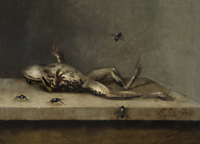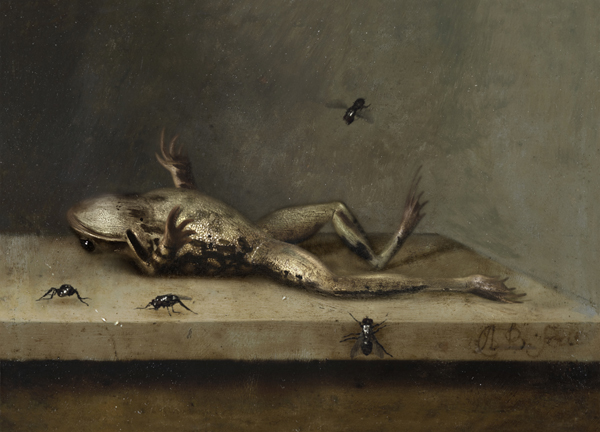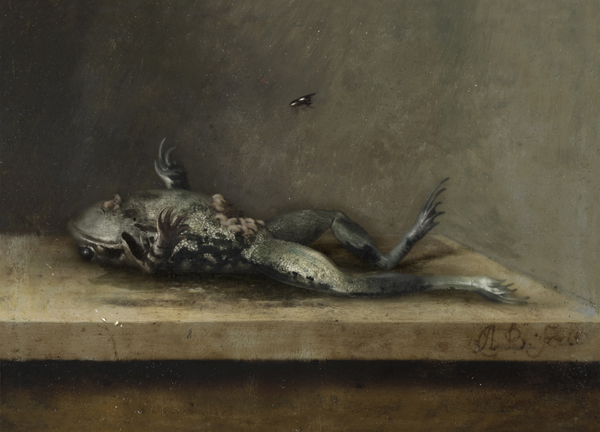
MPC animated a decomposing classical still life painting in real-time, recreating a Dutch painter’s brush strokes and realistic behaviour of flies and maggots.
MPC – Animating Still Life |
| Following their ‘Transforming Still Life Painting’ project made in 2012, MPC has continued their collaboration with artists Rob and Nick Carter and The Fine Art Society to complete another homage to a Dutch Golden Age Painting. This time, focussed on ‘Dead Frog with Flies’ and its slow decomposition shown over a 2 hour and 35 minutes sequence, the project uses real-time aspects to bring the painting to life. |
 |
|
The original scene was painted by Ambrosius Bosschaert the Younger. Born in 1609, the artist was the eldest son of Ambrosius Bosschaert, the master painter who created the ‘Vase with Flowers in a Window’ that inspired the previous ‘Still Life’ project. During the sequence the viewer witnesses the dying frog passing from the last stage of its life into a long period of decomposition. The frog swells and bloats, of course, then bursts open with maggots and slowly turns into a collapsed skeleton. The last limb to crumble resembles an outstretched human arm. Animation & Timeline DevelopmentThe main challenges for MPC fell into three areas. First, they created a frog in various stages of decay, second introduced flies and maggots with believable behavioural attributes, and finally maintained the painterly style seen in the original work throughout the new moving modern artwork. Creative Director Jake Mengers explained that to simulate the frog’s death sequence and subsequent decay, they studied reference material of all kinds of decomposing animals, mainly found on the internet. |
 |
|
MPC’s concept artists worked with Rob and Nick Carter through the development of the painting, creating seven style frames. The timeline was discussed verbally at the start to plan the animation, and they only developed the looks of the different stages as style frames later on. These frames were then mapped back to a shortened timeline and edit that ran through the action fairly quickly. The frames were not evenly spaced but represented key visual moments starting with the moment of the original painting. Then they extrapolated forward in time to its most bloated state, through the development of maggots to the bare skeleton stage with the flies. The process was similar in some ways to creating keyframes except that each part of the painting had to be treated in a different way at a different pace through the whole two and a half hour animation. Jake said, “The moving flies and maggots were handled as real-time animation sequences in which we updated every frame, while the decomposition of the flesh was relatively so much slower that we only had to render out every fourth frame and then frame-blended in between. Working on the multiple layers over such a duration was similar to working on two feature length films.” |
 |
Multiple RigsTo achieve the transition from the frog’s full body to its empty skeleton, the team used a series of displacement maps and model changes. These allowed the creation of varying shapes of decay and, combined with layers of transparency, enabled the disintegration of the flesh. The frog needed multiple rigs to give it the correct movement at different stages. The first one, used just after the frog’s death, was hand animated, later giving way to a solid body rig, which meant working with deformations instead of a moving creature, and finally changing to a rig for the collapsing skeleton. Again, different parts of the rig had to change over at different moments chosen according to what was happening on the timeline. They could release the leg, for example, from one rig to the next to allow it to collapse. “Comprising about 192,000 frames, the render on this project was very heavy,” Jake explained. “Although MPC has a large render farm, nevertheless we had to work very cost effectively in terms of frame rates. Further to those 192,000 frames were the numerous passes giving the project its painterly looks – specular, diffuse and reflection layers, a normal pass, motion vector pass – whatever we wanted to use in the composite had to be accounted for. |
 |
|
“Therefore optimization was critical. mental ray is not the best renderer for displacement maps,” said Jake, “but we were able to work in run-length, encoded compressed formats that would let us work to a limited disk space.” ZBrush was used to paint the displacement maps for the different looks set-ups, implemented through mental ray in Maya. The animation was done in Maya with proprietary rigging software, similar to what MPC’s team uses for feature film work, and optimized for their renderer. Flies and MaggotsThe flies and maggots were a further challenge for the team. They were each assigned various behavioural and intelligence attributes, such as the ability to avoid each other and be attracted to the most decomposed areas of the skin. The flying flies were animated with software that generates random flight paths. They made a database of flying and walking fly animations and wrote code to mix these up, producing various combinations of flight cycles with walk cycles, thereby maximizing the database. These were then baked into the fly images and refined to produce the scene-specific moves as the flies walk over the deforming frog. |
 |
|
“The maggots were quite different. We took onJulian Mann, a technical director and behavioural specialist, to write a special flocking system for these maggots. Using redefined particle distribution he was able to generate individual walk cycles and movement for them. His coding and algorithms avoided any repetition among them. There were so many maggots that the risk of viewers being aware of repeated movement over the scene was much greater than with the flies,” Jake said. Painter’s StyleOne of the most interesting qualities in the project is the painterly style evident from the original painting. The loose brushstrokes are visible throughout the sequence, meaning the painting continues to look like a painting, rather than a digital arrangement. The brush strokes required an understanding of the painter’s style, gained from Rob and Nick Carter, Kate Bryan from the Fine Arts Society and their own research. The original painting had been done on copper, not canvas, giving the strokes and paint a special quality. Bosschaert used a base coat of paint with more detailed strokes over this. The highlights were made with pointillist-like dabs. These qualities had to be separated into layers to replicate his style through the render, using a highlight pass, a diffuse pass and so on. |
 |
|
“Nuke was used to composite this complex system of layers into the expected look. Much like a complicated shader network in any software, it was an artist’s own creation. A project of this length would have taken Bosschaert about two months to finish and, meanwhile, generated a special technique not necessarily used on any other painting. “The frog was our main focus, reproduced through camera projections. We painted up the look of the broad brush strokes across its body, resulting in a ‘brush stroke render’. That way, the strokes stuck with his skin when we moved him. But even then it didn’t always look right - the stroke had to appear responsible for the shape. So, as the limbs turned relative to the camera, for example, we had to create painter-like strokes as well to compensate and reveal new viewpoints.” |
 |
|
The maggots also kept a painterly effect, best managed as a writhing mass where possible allowing them to blend into each other and helping to cope with some of the intersection problems they had with them. A complicated filtering process, at the 2D compositing stage, allowed refinement of the brushstroke effect and integration of the layers of 3D. The filters were created in Nuke as well and allowed them to treat specific areas with either a blurred effect, or more or less precise highlights. Some filters included motion vectors for the brush strokes when the frog moved, or edge detection for vignetting. www.moving-picture.com. |
| Words: Adriene Hurst Images: Courtesy of MPC |


















